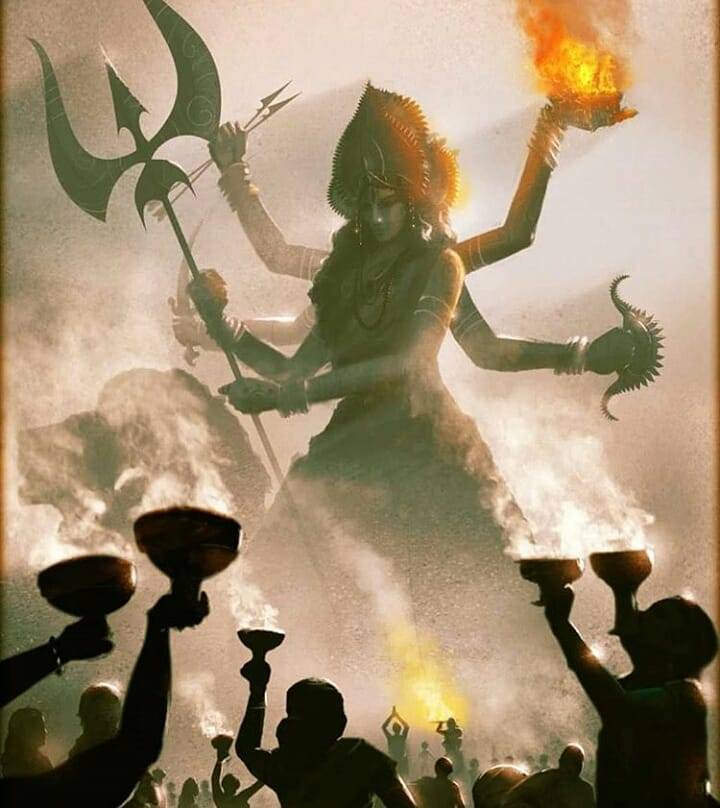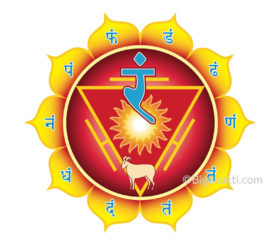This website uses cookies so that we can provide you with the best user experience possible. Cookie information is stored in your browser and performs functions such as recognising you when you return to our website and helping our team to understand which sections of the website you find most interesting and useful.
The Nine Nights Of The Goddess – Navarātri

Yoga and tantra provide maps and paths through the maze of complex existence. They aim to transform the body-mind from raw, mundane states of existence to refined, exalted states of experience and realization.
Within many yogic and tantric traditions, certain seasons, months, and times of the day are given special importance.
They are ‘auspicious’ times when cosmic energies are heightened and, as such, support psycho-spiritual practice. These auspicious moments in time assist us in achieving positive results. For example, dawn and dusk are said to be ideal times for yoga and meditation.
The festival of Navarātri or Nine Nights (‘nav’ is nine and ‘rātri’ is nights) is one of the great ceremonies in the lives of Hindus in India. The exact time of this celebration varies according to the lunar calendar. It begins on a dark moon in the Indian autumn (in the month of Ashwin, usually in October) and ends ten days after. In 2020 Navaratri starts on the 17th of October (depending on which part of the world and time zone you live in).
This period of The Nine Nights is devoted to invoking The Great Mother Goddess, The Divine Creative Power, or Shakti, the creator and supporter of the universe. She is most closely identified with Durga, an exquisitely beautiful goddess who rides a lion, and who wields in her many hands’ awesome weapons, including the ‘shul’ (pike), ‘chakra’ (wheel), ‘parashu’ (ax), and ‘talvar’ (sword).
Durga is said to be the manifestation of the power of all the goddesses that, long ago, faced a terrible and irresistible demon called Mahishasura.
Mahishāsura is a mythic representation of the human ego in its demonic form
Many yogis do not see Navaratri as a religious process, but rather as a psycho-spiritual one, and a unique opportunity for yogic practice.
They adopt certain practices and rituals to understand their psychological shadow and to confront their egos.
Normal human consciousness functions around an ego. Our ego manifests negative and destructive thoughts and behaviors when it functions from a self-centered, narcissistic place. When we are caught in the grip of an undeveloped, narcissistic ego our mind is plagued and colored by ‘poisons’ such as ignorance, pride, anger, and greed.
When we find ourselves caught in self-obsession, we feel anxious, depressed, and powerless, with no obvious way out of these thoughts and feelings.
It is only when the ego is in service to the Self that it is freed from the poisons and from anxiety, depression, and self-obsession.
Yogis make use of auspicious cosmic energies available during Navaratri to make a sincere and devoted attempt at success in their meditative practice (sadhana). It is possible to use this time to propel ourselves into a deep inner experience in which we touch something remarkable within ourselves.
Touching this deep spiritual essence nurtures and strengthens us and awakens us to a higher reality.
The unconquerable Goddess
In the mythology of India, even the gods felt powerless against the amazing force of the Great Selfish One, Mahishasura.
So they came together and pooled their energies to invoke the unconquerable goddess Durga, the goddess who overcomes all difficulties.
Durga represents the latent and unconscious power in all of us. If we can invoke this power, then we can align with our own higher being. This luminous part of us is the antidote to our self-made darkness. This part is best invoked by mantra and prescribed ritual, learned over a period of time, and performed with humility and devotion.
Within Durga are all the forms of Creative Power. She has three main manifestations:
- Kali – Goddess of destruction (of ignorance)
- Lakshmi – Goddess of wealth
- Saraswati – Goddess of knowledge
The combination of all these forces of the Creative Power is required to conquer our difficulties and the sorrows of existence that are manifested by our great ego.
We need to have the raw power of Kali to cut through the old habits and patterns, the prosperity of Lakshmi to have the means to move forward, and the knowledge of Saraswati to be able to manage our mind and lift it from its undisciplined state into a higher luminous state. This requires time and training to learn how to properly tackle and transform the little mind. Otherwise, it will resist.
Navaratri commemorates the victory of Durga over Mahishasura. Durga started her fight against this demon on the first day of Navaratri. The tenth day is the day of celebration of victory over our selfish nature and the enlightenment of our higher being.
How to make use of Navaratri
To make use of this time, make a resolve (a sankalpa), to achieve something great in your life, to overcome the obstacles you currently face, and to achieve a higher view of who you are and what your purpose is.
Eat a light vegetarian (sattwic) diet, preferably without grains, perhaps eating more fruit, milk, and vegetables.
Commit to a little extra sadhana, asana, pranayama, and meditation, and consciously channel the energy generated by this process toward attaining your exalted aim.
A good practice is mantra sadhana, so use the time to increase your mantra practice. The light diet will allow you to better feel the resonance of this mantra in your subtle being. If you don’t know mantra simply increase your meditation practice with greater intensity.
We wish you great blessings, empowerment, and joy in practice over this time, and always.
To increase awareness of your sankalpa see Illuminating Your Heart’s Desire.
To get to know your psychological shadow see Facing the Shadow Seminar.
Share
Latest Posts
Meditation
Yoga
Wisdom
Chakras
Get Wellbeing and Wisdom Updates
"*" indicates required fields



